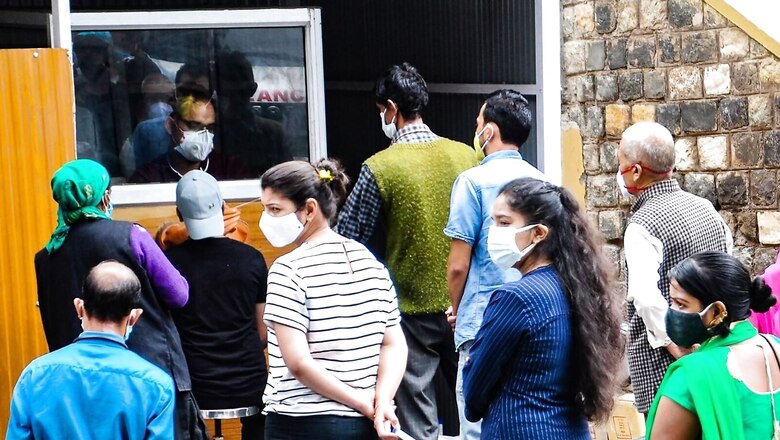
views
India continued to witness a rise in the Covid graph with the R-factor of several states increasing. Data release by the government on Tuesday showed eight states showing a rise in the R-factor. Kerala, Tamil Nadu, Mizoram, Karnataka, Puducherry, Jammu and Kashmir, Himachal Pradesh and Lakshadweep are the states where the R-factor was more than 1. the government in its bulleting said that Covid was still very much present in India, even as several states have eased restrictions.
The R-factor, which indicates the speed at which COVID-19 infection is spreading in the country, is climbing steadily with Kerala and the northeastern states occupying top spots fuelling worries about the pandemic rearing its head again. An analysis by researchers at the Institute of Mathematical Sciences in Chennai shows that the R-values of among the metro cities, including Pune and Delhi, are inching towards one.
What Does the R-value Indicate?
An R-value of 0.95 means, every 100 infected people on an average pass on the infection to 95 other individuals. If the R-value is lesser than one, it means the number of newly infected people is lower than the number of infected people in the preceding period which means the disease incidence is going down. The smaller the value of R, the faster the disease is on the decline. Conversely, if R is greater than one, then the number of infected people is increasing in each round — technically, this is what is called the epidemic phase. The bigger the number is than one, the faster the rate of spreading of the disease in the population.
Both the daily rise in cases and active infections have remained more or less the same. When the number of active cases remains in the range of a few hundred and the R-value is near one, then an outbreak can be controlled much easier, PTI quoted Sitabhra Sinha of the Institute of Mathematical Sciences, who is leading the team.
India’s Overall R-value
When the second wave of the COVID-19 infection was at its peak, the overall R-value in the country was estimated to be 1.37 between March 9 to April 21. It declined to 1.18 between April 24 and May 1 and then to 1.1 between April 29 and May 7, according to the analysis.
Between May 9 and 11, the R-value was estimated to be around 0.98. It dropped to 0.82 between May 14 and May 30 and further to 0.78 from May 15 to June 26. The R-value however rose to 0.88 from June 20 to July 7 and then to 0.95 from July 3-22. “India’s overall active cases are fluctuating too much to get a reliable estimate, but data is pointing at a value close to one. It may tip over either way in the coming few days,” said Sinha.
Worrying Trend in Kerala
Kerala has the highest number of active cases and continues to have an R-value around 1.11. “Looks like it will remain in the top spot for the next couple of weeks. The Northeast continues to have a very bad situation with most states having R-value more than one,” Sinha said.
The Union Health Ministry on Thursday said it will depute a six-member team to Kerala for effective COVID-19 management as the state reports a spike in daily cases. The team headed by National Centre for Disease Control Director S K Singh will reach Kerala on Friday and visit some districts reporting a high case positivity rate. The high case positivity has remained a cause of concern at a time when the overall coronavirus numbers are on a decline in the country.
Kerala on Wednesday recorded 22,056 fresh COVID-19 cases pushing the infection caseload to 33,27,301, with the number of people who succumbed to the virus rising to 16,457 with 131 more deaths. In the northeast, only Tripura has an R-value substantially lower than one while Manipur has gone only marginally below one. Among other states in India, Uttarakhand has an R-value very close to one at the moment.
Rise in R-value in Major Cities
Among the major cities, the R-value of Delhi was inching towards one. The R-value between June 21- 26 was 0.8. It declined to 0.66 between June 28 and July 6, but rose to 0.84 between July 4 and 20. The national capital on Thursday recorded 51 fresh COVID-19 cases with a positivity rate of 0.08 per cent. Active cases in Delhi stand at 554.
Explaining the situation in the national capital, he said if the number of active cases is constant, then the R-value is one. “Even if R momentarily goes over one, there is a possibility that you can contain it. For example, if the active cases are in hundred, you still have the possibility that you contain it before it goes completely out of hand. “Once it goes to a few thousand and R is greater than one then the situation is dangerous,” Sinha explained. The R-value of Pune was 0.85 between July 11-13 and 0.89 between July 15-20. For the national capital, the R-value between June 21- 26 was 0.80. It dropped to 0.66 from June 28-July 6, but it rose to 0.84 between July 4-20.
For Bengaluru, the R-value from July 7-13 was 0.92. It increased marginally to 0.95 from July 13-17. It dropped to 0.72 from July 17-23. In the case of Mumbai, the R-value was 0.96 between July 2-4. It dropped to 0.89 between July 6-9. It further dropped to 0.74 between July 22-24.
For Chennai, the R-value between June 29 to July 7 was 0.63. It shot up to 1.05 between July 16-19. It was 0.94 between 21-24, showing signs of decline. In the case of Kolkata, the R-value was 0.80 between July 1-13, followed by 0.91 between July 12-17. It dropped to 0.86 between July 17-24.
(With PTI inputs)
Read all the Latest News, Breaking News and Assembly Elections updates here.




















Comments
0 comment